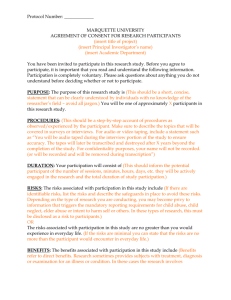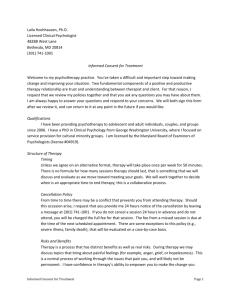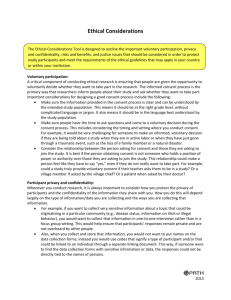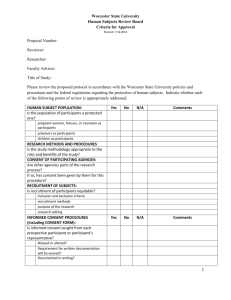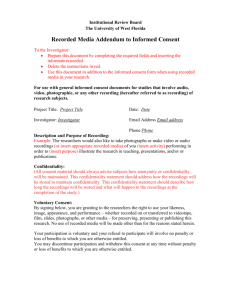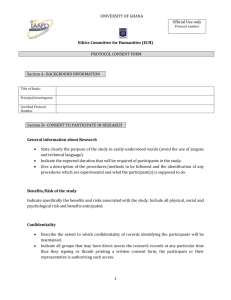Research Protocol Checklist: Study Design & Methods
advertisement
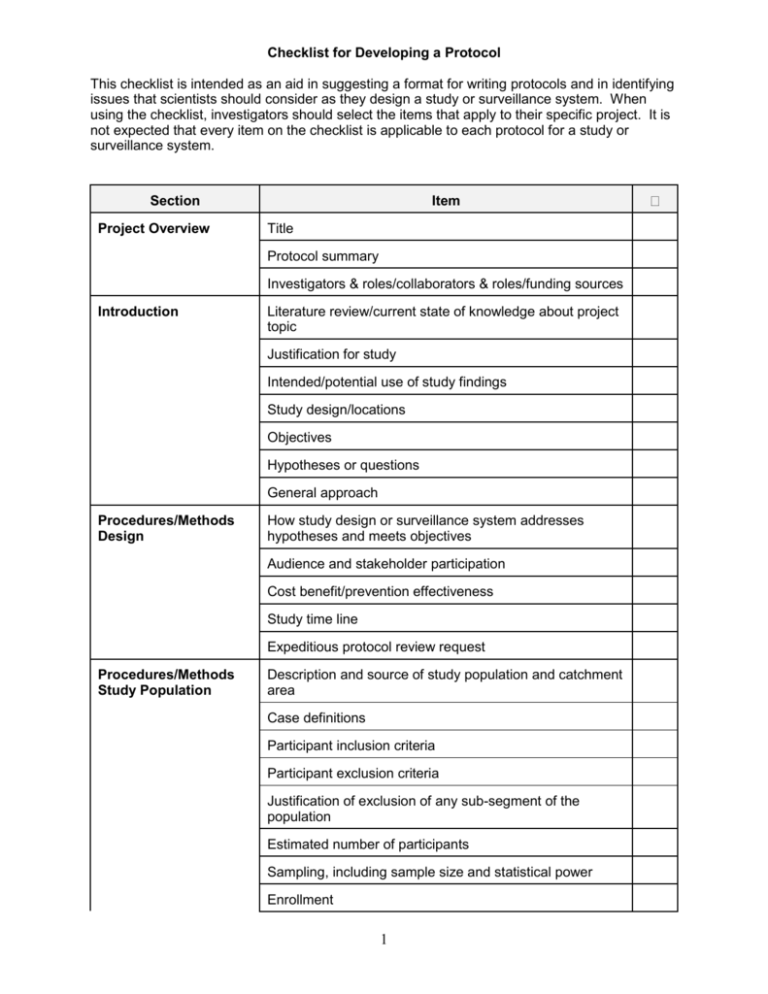
Checklist for Developing a Protocol This checklist is intended as an aid in suggesting a format for writing protocols and in identifying issues that scientists should consider as they design a study or surveillance system. When using the checklist, investigators should select the items that apply to their specific project. It is not expected that every item on the checklist is applicable to each protocol for a study or surveillance system. Section Project Overview Item Title Protocol summary Investigators & roles/collaborators & roles/funding sources Introduction Literature review/current state of knowledge about project topic Justification for study Intended/potential use of study findings Study design/locations Objectives Hypotheses or questions General approach Procedures/Methods Design How study design or surveillance system addresses hypotheses and meets objectives Audience and stakeholder participation Cost benefit/prevention effectiveness Study time line Expeditious protocol review request Procedures/Methods Study Population Description and source of study population and catchment area Case definitions Participant inclusion criteria Participant exclusion criteria Justification of exclusion of any sub-segment of the population Estimated number of participants Sampling, including sample size and statistical power Enrollment 1 Section Item Consent Process Procedures/Methods Variables/Interventions Variables Study instruments, including questionnaires, laboratory instruments and analytic tests FDA Investigational New Drug (IND) or Investigational Device Exemption (IDE) information Intervention or treatment Outcomes and minimum meaningful differences Training for all study personnel Procedures/Methods Data Handling and Analysis Data analysis plan, including statistical methodology and planned tables and figures Data collection Information management and analysis software Data entry, editing and management, including handling data collection forms, different versions of data and data storage and disposition Quality control/assurance Handling results in the absence of a reference test Measurement/estimation and adjustment for cross reactiv ity Verifying independence of tests used to confirm results of new test being studied Bias in data collection, measurement and analysis Intermediate reviews and analyses Limitations of study Procedures/Methods Handling of Unexpected or Adverse Events Response to new or unexpected findings and to changes in the study environment Identifying, managing and reporting adverse events Emergency care Procedures/Methods Dissemination, Notification, and Reporting of Results Notifying participants of their individual results Notifying participants of study findings Anticipated products or inventions resulting from the study and their use 2 Section Cont. Item Disseminating results to public References Appendix Materials Data collection forms Proposed tables and figures 3 Guide for General Protocol Checklist PROJECT OVERVIEW Title: Summarize the main idea under investigation. The title should be able to stand alone as an explanation of the study. Protocol summary: Give a concise overview of the project. Describe the purpose of the study, including problem to be investigated and hypothesis(es) to be tested, the population, and the methods that will be used. Avoid the use of acronyms. Include the expected benefit of the study. Investigators/collaborators/funding sources: Include the names and degrees of all investigators and their roles in the project. Note any conflict of interest for each investigator and acknowledge all funding sources. INTRODUCTION Literature review/current state of knowledge about project topic: Discuss relevant information about the subject of the project based on a review of the literature. In the Reference section, attach a bibliography of the sources used. Justification for study: Explain the public health and scientific importance of the study. In the context of previous studies, describe the contribution this study will make. Intended/potential use of study findings: Define the primary target audiences and discuss the expected applicability of study findings. Study design/locations: Describe the study design and the locations where the study will be conducted. Objectives: Clearly and concisely list the objectives that the project will address. Hypotheses or questions: List the clear and focused question(s) that the study will answer. State the type of hypothesis(es) that will be explored or tested. General approach: Describe whether the approach used will be descriptive, exploratory (hypothesis-generating), confirmatory (hypothesis testing), or developmental (focused on corrective action). PROCEDURES/METHODS DESIGN How study design or surveillance system addresses hypotheses and meets objectives: Explain the appropriateness of the study design to the project and to the questions and objectives previously outlined. Distinguish between procedures that are experimental and those that involve routine care. Identify specific design attributes that characterize the study design (e.g., cross-sectional survey, case/control, cohort, focus group, chart review, etc.) or surveillance system (e.g., description of the system as active or passive, defining reported cases as individual versus aggregate and as laboratory confirmed or not). Audience and stakeholder participation: Define the primary audiences for the project. Assess the major stakeholders and describe ways they can (and cannot) participate in the study. Explain the process by which those affected by the study can express their views, clarify their needs, and contribute to the project. Cost benefit/prevention effectiveness: Describe how these measures will be addressed. 4 Study time line: Provide a calendar with estimated dates for implementing and completing key activities. Expeditious protocol review: If appropriate, describe the need for an expeditious review of the protocol (e.g., because it is for an ongoing outbreak or emergency disaster). STUDY POPULATION Description and source of study population and catchment area: Demographically and in terms of the specific public health conditions to be studied, define the population from which the participants, sample or surveillance subjects will be drawn and to what population inferences will be made. Case definitions: Provide descriptions of illness, condition or health event which defines a study participant as having that condition. Participant inclusion criteria: Describe conditions or characteristics applicable to the identification and selection of participants in the study and the conditions necessary for eligible persons to be included. Participant exclusion criteria: Describe characteristics that would disqualify otherwise eligible participants from the project. Justification of exclusion of any sub-segment of the population: If a sub-population as defined by gender, race/ethnicity, or age is excluded, provide reasons. In accordance with CDC's policy for inclusion of women and minorities in research, state how these populations are included in the sponsoring CIO's overall program of research if excluded in this particular study. Estimated number of participants: State the estimated number of participants for the study. For a project establishing or using data from a surveillance system, this may include the expected number of reported cases per reporting period for epidemic and non-epidemic periods. Sampling, including sample size and statistical power: Describe the sample (e.g., the sample will be one of convenience, a population-based representation or systematically chosen for some other purpose). State the sampling units and units of analysis. Estimate required sample sizes to answer questions and test statistical hypotheses (based on available information from pilot studies or previous reports). Include statistical power estimates. Explain the conditions under which sampling estimates would be revised. If group-level or aggregate information will be collected (e.g., from focus groups), explain how the groups will be comprised, or what procedures will be followed to create appropriate groups. Enrollment: Describe the manner in which potential participants will be contacted, screened, and registered in the study. Describe procedures for tracking the number of persons who withdraw from the study. Explain the procedures for assigning participants to different groups. Include a discussion of how departures from the intended enrollment procedures will be handled and documented. Consent Process: Describe procedures for informing participants about study and methods and for obtaining consent. VARIABLES/INTERVENTIONS Variables: List and briefly describe the categories, topics, or domains of information to be explored and variables to be collected. Address consistency of definition of variables for data 5 collected from multiple sources. Traditionally, for outbreak investigations, Atime@, Aplace@ and Aperson@ would be collected to construct the epidemiologic curve. Explain how the variables will be utilized and the process by which variables will be defined. Study instruments, including questionnaires, laboratory instruments, and analytic tests: Describe strategies to elicit information, including specific techniques and study and laboratory instruments, and explain how they will be used. Describe the attributes of those strategies/ instruments as demonstrated in other studies, including appropriateness, validity and reliability within the particular study populations, sensitivity and specificity of instruments, how well they yield reproducible results and whether any controversial methods are being used. Include a discussion of how changes to the study instruments will be handled and documented. FDA Investigational New Device (IND) or Investigational Device Exemption (IDE) information: If the study involves the use of an investigational new drug or investigation new device, provide the IND or IDE number and relevant information. Intervention or treatment: Describe the types of interventions or treatments that will be tested in detail, including dosing, schedules of administration, etc. Outcomes and minimum meaningful differences: List the possible results of exposure or intervention of interest in the study (i.e., the outcomes) and what clinical or epidemiologic differences in measurement of the outcomes are important to detect. Training for all study personnel: Describe training, such as interviewer techniques, data collection and handling methods or informed consent, provided to study personnel. Address how inter-observer differences will be handled. DATA HANDLING AND ANALYSIS Data analysis plan, including statistical methodology and planned tables and figures: Describe the sampling methods, information collection procedures, methods to maximize response rates, test procedures and relevant statistical quantities (e.g., variance, confidence intervals and power based on data from the study) in sufficient detail that the methods are reproducible. This includes calculation of relevant quantitative measures for tests and instruments, such as sensitivity and specificity. In outbreak investigations, it is common to employ an iterative process in the analysis (consisting of developing and testing hypotheses and planning and evaluating interventions) to identify the source of the outbreak and control it. For projects establishing or utilizing data from a surveillance system, this could include how and how often the surveillance system will be evaluated. Describe what tables and figures are planned to present study results. Data collection: Describe data collection procedures, processes and documentation. For data emanating from a surveillance system, this would include frequency of reports. Information management and analysis software: Provide the names of data entry, management and analysis software packages and computer programming languages to be used for the project. Data entry, editing and management, including handling of data collection forms, different versions of data, and data storage and disposition: Describe the overall procedures for management of the data collected. Include in the description the process for entering and editing data. Describe how study materials, including questionnaires, statistical analyses, unique reagents, annotated notebooks, computer programs and other computerized information, whether used for publication or not, will be maintained to allow ready, future access 6 for analysis and review. Document operating procedures for managing and accessing different versions of data sets. State to whom the data belongs, and any rights and/or limitations to access for primary and secondary data analyses and publications. Document procedures regarding confidentiality of the data, including how confidentiality will be preserved during transmission, use and storage of the data and the names of persons or positions responsible for technical and administrative stewardship responsibilities. Document what the final disposition of records, data, computer files, and specimens will be, including location for any relevant information to be stored. Records must be stored in compliance with CIO or Agency guidelines. Quality control/assurance: Describe the steps that will ensure no unintended consequences that could affect the quality of the data. Those steps might include methods to capture all reported data exactly as received, assuring logical consistency among all parts of a record and ensuring that manipulation or transformation of the data (e.g from audio tape to transcribed text) produces no unintended changes, and verifying that statistical and arithmetic calculations are performed as proposed in the data analysis plan. For outbreak investigations, this would include verifying diagnosis and confirming the outbreak. Describe procedures for ongoing data quality monitoring to assure that information of appropriate depth, breadth, and specificity is collected and remains consistent within and among staff over time, and acceptable levels of such attributes as validity, reliability, reproducibility, sensitivity and specificity are achieved. Handling results in the absence of a reference test: Describe how tests will be used and results interpreted in the absence of a referent test and/or consensus of multiple test results. Include how sensitivity and specificity are affected. Measurement/estimation and adjustment for cross reactivity: Describe how cross reactivity will be measured, its potential effects on test results and how it will be accounted/adjusted for in the analysis. Verifying independence of tests used to confirm results of new test being studied: Describe process to validate results and use of new test, including verification of independence of tests or adjustments made for non-independence. Bias in data collection, measurement and analysis: Describe the kinds of bias that may occur in collecting the data or in the measurement or analysis phases, and the steps that will be taken to avoid, minimize and compensate for the bias. Include factors in the study population or in study personnel that could bias results, as well as the steps that will be taken to assure valid self-reporting or recording of observations. Include any randomization and blinding procedures that will be used to eliminate/minimize bias by investigators, other study staff or participants (e.g., in selection of participants, allocation to treatment groups, providing/receiving treatment). Intermediate reviews and analyses: Describe the ways that progress will be tracked and the study will be evaluated prior to assessing final results. Limitations of study: Explain factors that might reduce the applicability of study results. Discuss potential weak points or criticisms of the study, including alternative methods. HANDLING OF UNEXPECTED OR ADVERSE EVENTS Response to new or unexpected findings and to changes in the study environment: Describe procedures for identifying and handling new or unexpected findings, and responding to changes in the study environment. Identifying, managing, and reporting adverse events: Describe the types of adverse events that might be encountered and how study personnel will be trained to react. Describe methods 7 that will be used to track adverse reactions and their potential impact on the study. Emergency care: Explain the actions that would be taken in the event that an emergency develops during a study participant=s involvement in the research. DISSEMINATION, NOTIFICATION, AND REPORTING OF RESULTS Notifying participants of their individual results: Describe the process used to notify study participants of their results, including those of immediate importance. Include precipitating circumstances and whether or not counselors will be used. Notifying participants of study findings: Explain whether the participant will be offered the option of receiving overall study findings and the form they will take. Anticipated products or inventions resulting from the study and their use: List any products, including inventions, derived from the study, and how those will be used. Disseminating results to public: Define effective communication channels and best formats for presenting information that will be used to disseminate project results to specific target audiences. REFERENCES List bibliographic references used to create and delimit all aspects of the study. APPENDIX MATERIALS Data collection forms: Include any forms or documents used to collect data or from which data are abstracted. Examples of these are questionnaires, medical records and other abstraction forms. Proposed Tables and figures: Provide table shells and examples of figures for presentation of data and study results. Other relevant documents: Include any other relevant supplementary materials. 8 SUPPLEMENTAL PROTOCOL CHECKLIST PROTECTION OF HUMAN RESEARCH PARTICIPANTS Section Risks Notes Physical Social Psychological Methods to Minimize Risks anticipated Benefits Risk/Benefit Ratio Vulnerable Populations Pregnant Women, Fetuses, in vitro Fertilization Prisoners Children Implementation/ Documentation of Informed Consent Justification for Waiver/Alteration of Informed Consent Justification for Waiver/Alteration of Documentation of Informed Consent Implementation/ Documentation of Assent (children) Implementation/ Documentation of Parents=/Guardians= Permission Protection of Privacy and Confidentiality Privacy of Individual Assurance/ Certificate of Confidentiality Assurance of Confidentiality (308(d) PHS Act; protects both individuals and institutions) Confidentiality of Data Certificate of Confidentiality (301(d) PHS Act; protects only individuals 9 Section Extra Costs Notes Reimbursements/ Incentives Appendix Material (Relevant Supplementary materials) 10 SUPPLEMENTAL GUIDE FOR PROTOCOL CHECKLIST PROTECTION OF HUMAN RESEARCH PARTICIPANTS Description of risks (physical, social, psychological) to the individual or group. Include methods to minimize risks: Define the nature, magnitude, probability, and duration of potential harms that a person may receive by participating in this research. Describe steps that have been taken to minimize risks, including the use of sound research design and by using procedures already being performed on the participant or other routine procedures that will be provided to the participant. Description of anticipated benefits to the research participant: Discuss benefits to research participants resulting from the research. Describe the steps that have been, or will be, taken to maximize benefits. Description of the potential risks to anticipated benefit ratio: Justify that the potential risk are reasonable in relation to anticipated benefits and the importance of the knowledge that may reasonably be expected to result from the research. Justification for involving vulnerable participant populations: If study participants include a special or vulnerable population, such as children, prisoners or mentally incompetent, provide justification for their use in terms of the purpose of the research. Procedures for implementing and documenting informed consent: Describe procedures for informing participants and methods to obtain and document consent. Justification for waiver or alteration of informed consent: If informed consent will not be obtained or will be altered, describe the justification for waiver. The justification must address the four criteria for waiving or altering consent: 1) the research involves no more than minimal risk to the participants, 2) the waiver or alternation will not adversely affect the rights and welfare of the participants, 3) the research could not practicably be carried out without the waiver or alteration, and 4) whenever appropriate, the participants will be provided with additional pertinent information after participation. Justification for waiver of documentation of informed consent: If written informed consent will not be obtained, provide justification for obtaining consent through other means. The justification must address one of the two criteria for waiving documentation: 1) that the only record linking the subject and the research would be the consent document and the principal risk would be potential harm resulting from a breach of confidentiality or 2) that the research presents no more than minimal risk of harm to participants and involves no procedures for which written consent is normally required outside of the research context. If the first criterion is used, describe the procedures to ensure that participant wishes regarding documentation linking them to the research will be ascertained and honored. Description of procedures for implementing and documenting the assent process of children: Describe procedures for informing children and methods to document assent. Description of procedures for implementing and documenting parents= or guardians= permission: Describe procedures for informing participants and methods to document parental permission. Provisions for protecting privacy/confidentiality: Explain provisions for protecting study participants from being identified either directly or indirectly. If for any reason data identifying subjects will be published or released to persons outside of the project, explain why this is 11 necessary. Statement about need or lack of need for assurance or certificate of confidentiality: This refers to formal assurances and certificates of confidentiality. Statement of extra costs to participants due to involvement in the study: Self explanatory. Description and justification of reimbursements or incentives that will be used: Self explanatory. If the study involves special populations, such as pregnant women, fetuses, prisoners, children or human in vitro fertilization, include a section that specifically addresses the requirements of HHS regulations 45 CFR 46. 1. If fetuses are included, see Subpart B of 45 CFR 46. 2. If pregnant women are participants, see Subpart B of 45 CFR 46. 3. If human in vitro fertilization is used, see Subpart B of 45 CFR 46. 4. If prisoners are participants, see Subpart C of 45 CFR 46. 5. If children are participants, see Subpart D of 45 CFR 46. APPENDIX MATERIALS Include all relevant supplementary materials. All materials for use by participants must be written in lay language. Announcements/advertisements, notification letters, videos, scripts, other information for participants: Recruiting literature should include the purpose of the research and the selection criteria for inclusion in the study, a straightforward and simple description of the study, potential risks and benefits, method of compensation for time and inconvenience, the location of the research, sponsoring agencies, the person to contact for further information, an estimate of the time per session and total time of participation. Data collection forms Questionnaires, interview schedules, observation plans, focus group discussion guides, etc. Coding guidelines and definitions of themes/variables Medical records and / or other abstraction forms Request and authorization for release of medical records Manuals for training study personnel. Consent and assent forms 12

